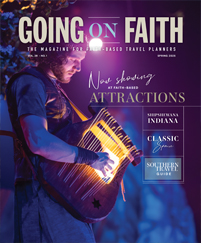America is often called the Land of Opportunity and has attracted cultures from around the globe dating back to its pre-Colonial days.
Since that time, numerous immigrant communities have established their own cultural enclaves across the country, each offering its own unique international flavor and flair.
Following are four distinctive ethnic destinations to add to your group travel itinerary — no passport required.
Lindsborg, Kansas
What do Handel’s “Messiah,” International Waffle Day and St. Lucia have in common? Lindsborg, Kansas.
Located approximately 195 miles from Kansas City and 230 miles from Oklahoma City, Lindsborg — population 3,500 — is widely recognized as “Little Sweden, USA.”
Founded in 1869 by Swedish immigrants, Lindsborg has lovingly preserved its rich heritage and culture, making it a wonderful tourism destination.
“Lindsborg is one of the better known tourism destinations in Kansas, and it happened purely by accident,” said Holly Lofton, director of the Lindsborg Convention and Visitors Bureau. “In the late 1800s, many people came here from across the country for the Messiah Festival of the Arts, arriving by the railroad that stopped here before car travel became available.”
Today, the 136-year-old, 10-day festival, held in conjunction with Holy Week, encompasses theater performances and visual arts experiences, and its namesake is the longest running performance of Handel’s “Messiah” in North America.
Group activities include tours to sites and attractions like the Höglund Dugout, an example of an early Scandinavian home built below ground. Historic structures in town include the Swedish Pavilion and the Old Roller Mills, named among the “The Eight Wonders of Kansas,” the only fully restored wooden roller mill in the country.
Traditional Swedish fare awaits in the walkable downtown area. The aptly named Swedish Crown Restaurant serves delicious Swedish and American dishes with an unusual twist, and the Swedish Country Inn offers a Swedish breakfast buffet.
Take home a bit of Sweden, like tasty herring or Swedish meatballs, at places like Anderson Butik. Courtyard Bakery and Gallery features authentic Swedish baked goods and pastries. And Hemslöjd — Swedish for “handicraft” — sells a variety of Scandinavian gifts, including the popular traditional Swedish Dala Horses.
Annual celebrations include the St. Lucia Festival, a winter solstice tribute to the Italian saint who brought light and sustenance to Sweden’s suffering people, and Våffeldagen (International Waffle Day) in March. Svensk Hyllningsfest, held in October in odd-numbered years, is Lindsborg’s largest festival; it is highlighted by traditional dances, music and a full Swedish smorgasbord that feeds 700 people.
Miami’s Little Havana, Florida
Don’t be fooled by the diminutive in the name Little Havana. This Cuban gateway to Latin America and the Caribbean is big on history and authentic experiences, making it one of the most distinctive heritage tourism destinations in the country.
Dating back to the 1930s, the area has always been a melting pot of Hispanic and Latin cultures: Cubans fleeing from social, economic and political strife in Cuba, as well as immigrants from Puerto Rico, Colombia, Nicaragua, Mexico and the Dominican Republic, among others. Together, they have created a vibrant multicultural landscape bursting with energy and tradition at every turn.
The main drag, extending almost two miles in the heart of Miami, is Calle Ocho (Southwest Eighth Street). It and its connecting side streets are peppered with insightful monuments, imaginative murals, historic attractions, captivating music and warm, welcoming people.
For example, you’ll find a 16-foot-long bronze raised map of Cuba, statues of the Virgin Mary and the Eternal Torch of Brigade 2506, which pays tribute to the lives lost in the 1961 Bay of Pigs Invasion of Cuba.
“Although Little Havana is in the U.S., it feels like walking in a very different culture and place,” said Connie Kinnard, vice president of multicultural tourism and development for the Greater Miami Convention and Visitors Bureau. “Visitors enjoy a very walkable, authentic experience here, from the shops where they roll premium handmade cigars in the traditional fashion to watching domino games and competitions at Domino Park to enjoying a Cuban coffee to places like Hoy Como Ayer [Today Like Yesterday] Bar and Lounge for great live entertainment, food and dancing.”
On the culinary front, locally owned places like Azúcar Ice Cream Company; El Cristo Restaurant and Catering, which serves Cuban-American cuisine; and the Spanish-inspired Casa Juancho offer dishes made from Abuela’s (Grandma’s) recipes with a modern twist.
Miami area denizens and visitors flock to the immensely popular Viernes Culturales (Cultural Fridays) the last Friday of each month to enjoy talented street performers, live music, salsa lessons, art gallery exhibits and more.
Be sure to meander along the Latin Walk of Fame of Little Havana, which honors Latino entertainers, artists, and personalities including Celia Cruz, Julio Iglesias, Olga Guillot, Gloria Estefan and the Miami Sound Machine, Pedro Vargas and Thalia.










